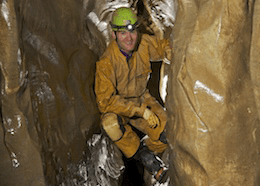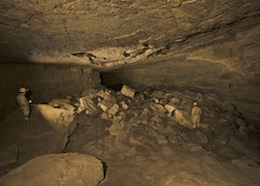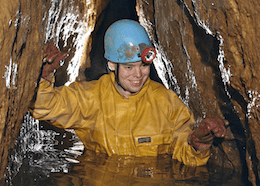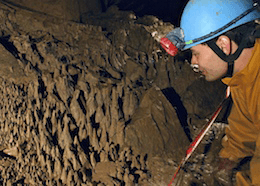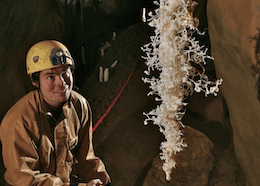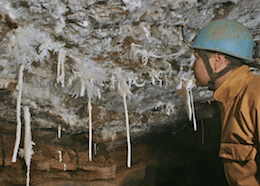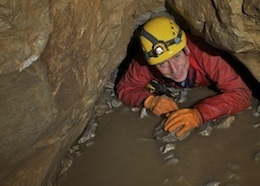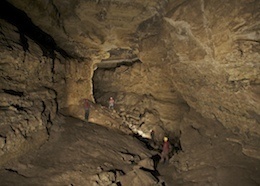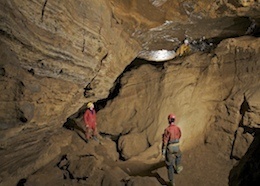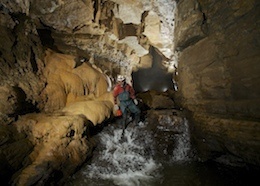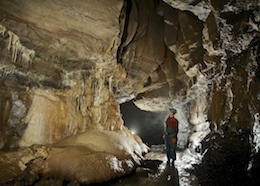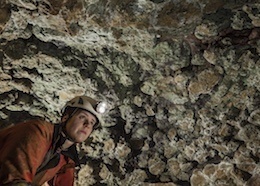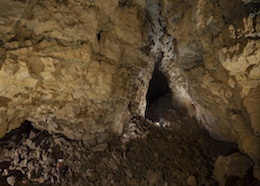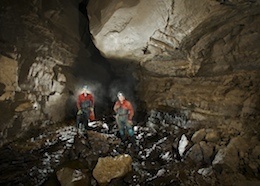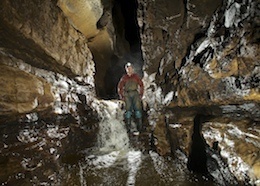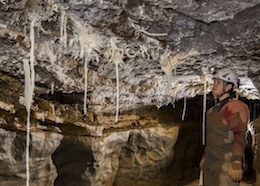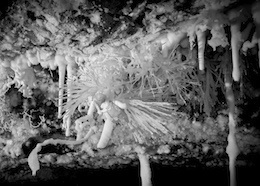Overview
Agen Allwedd also known simply as Aggy is the longest cave system on Llangattock. The cave is a famous roost for bats which can be seen roosting in the side passages of the entrance series in the winter months. The cave system is one of the longest in the country with over 30km of passages and as such offers a number of classic caving trips. Length 30,000m +
Altitude 366m
Grid Reference SO 18758 15895
History
The Agen Allwedd entrance was first investigated on Christmas Eve 1949 by Brian Price and a couple of companions, who managed to move a boulder blocking progress. In a follow-up visit the passage was explored further but thought to close down. On the 2nd January 1950 accompanied by Harold Hicken, David Seagrove they found the way through to the main passage and explored it up to the First Boulder Choke. It was not until 1957 that the Hereford Caving Club managed to dig through this choke and enter the main complex of the cave. In late 2005 while digging in Iles Inlet in an attempt to find the elusive connection to Daren Cilau a team of explorers discovered 300m of the most beautiful passage in the system ending in the spectacularly decorated Corkscrew Chamber.
British Caving Library - Interview with Brian Price on the discovery of Agen Allwedd
British Caving Library - Interview with Clive Westlake on the creation of the Grand Circle
British Caving Library - Interview with Martyn Farr on diving in Agen Allwedd
British Caving Library - Interview with Mel Davies on the first excavation of Upper Trident Passage
British Caving Library - Interview with Paul Hartwright on the discovery of the Summertime Series
Location
Agen Allwedd is located on the old Llangattock tramroad about 1700m west of the Chelsea Spelaeological Society cottage - Whitewalls. The original very tight entrance to the cave is no longer used, instead the gated Ogof Gam entrance is used. Llangattock Google map showing the location of Agen Allwedd and other caves in the area.
Location map - click marker to show entrance photo
Access
The cave is gated for conservation reasons. The access is managed on behalf of Natural Resources Wales through the Mynydd Llangattwg Cave Management / Advisory Committee
Description
Agen Allwedd is a long system with areas of complex route finding so a full description of the cave is not given here. There are several notable standard routes that can be undertaken in the cave. A trip through the First Boulder Choke into Baron's Chamber and then down the 1200m long Main Passage with its impressive dried mud floor to the Music Room offers a gentle introduction to this cave. For the more adventurous the Grand Circle following the Main Streamway through the Second, Third and Fourth Boulder Chokes to the main sump and then returning via the long and unpleasant Southern Stream Passage is one of South Wales most classic trips. The Inner and Outer Circle routes accessed via the Turkey Streamway offer arguably the more interesting trips in the cave, with pristine crystal covered passage walls in Selenite Needle Passage, the massive Dome of St. Paul's and the very interesting Swiss Village Mud formations. In recent years an attempt to forge a link with the neighbouring Ogof Daren Cilau has resulted in the discovery of some of the most impressive formations in the UK in Iles Inlet, accessed via Southern Stream Passage and the Priory Road.
Entrance Series to Baron's Chamber
The original Agen Allwedd entrance is blocked part way in so visits are now made through the gated Ogof Gam entrance. The entrance series is varied in character with squeezes, crawls and traverses leading to the First Boulder Choke which provides the route into Baron's Chamber and the main cave.
Past the gate a short wet crawl over cobbles leads to a walking rift passage where a logbook is found. The passage continues mostly as a rift passage, but on occasions you have to climb over boulders or traverse over tighter sections if you are above average build. There are two low sections where you pass through flat out and in the past these have contained pools of water, but are now drained. A junction is reached - the Tool Shed where to the right is the passage that links to the original Agen Allwedd entrance. In the entrance series the route is found by taking the left hand branches at floor level junctions, the first of these being a low crawl and the second a stooping passage. The passage then becomes larger and the route is over the top of boulders. This passes two high level passages - Angel's Roost and then Queer Street which are taped off to protect the bat roosts. Beyond this a choke is reached where the boulder collapse reaches the roof and there is a tape across the passage. The way into the choke is a few metres back where the polished boulders on the right of the passage indicate the route. Dropping through reaches a void where you pass over the first hole to reach a further drop down that reaches a descending tube leading down to a small stream. Here Draught Passage leads off to the right, while below is the way to the stream that is followed in a rift to reach the First Boulder Choke. Following the polished path through the boulders with the passage wall on the left brings you out onto the top of a boulder slope in Baron's Chamber. It is worth taking note of the point where you emerge into the chamber as it is not obvious on the return.
Baron's Chamber via Main Passage to North Wing
The impressive Main Passage heads off for over 1200m from the boulder slope at the end of Baron's Chamber. This is comfortable walking passage over a dried mud floor for most of its length, with just a few sections where you need to stoop. Towards the end there are some short sections of crawling as the passage first meets the Music Room and then the Cliffs of Dover to eventually lead to the North Wing.
On emerging from the First Boulder choke you arrive near the top of a massive boulder slope overlooking Baron's Chamber. Above the route through the choke there is a higher route that leads for about 30m above the choke. Heading down the boulder slope from the choke leads you through Baron's Chamber where the passage swings around to the left. Walking ahead over the boulders the the passage gains a great deal of height as the floor descends down to a low point of the passage. Here the floor becomes covered in dry mud and to the right a hole down leads to a short crawl and the route into the Main Streamway. Following the passage past this junction a steep ascent is made up a mud slope to reach the ongoing Main Passage. At the top of the slope a large passage on the right is Erse Passage. The slope up to Erse Passage is steep and leads past some massive boulders to a balcony at the top where you overlook the Main Passage. At the back on the left a small dig heads off that becomes a flat-out crawl after a few metres. The flat-out section immedialey emerges in the bottom of a hollow in the side of a large chamber. This first chamber in Erse Passage is has an almost circular collapse ceiling with a central flat roof and a many thin layers of shales in the domed sides. From this chamber a passage leads off and passes below another similar chamber. This second chamber is reached by a very loose climb up in the passage and is similar to the first, but missing the floor! Ahead the passage continues to enter the final chamber, this has the banded rocks in the walls and flat roof similar to the other chambers on the side where you enter. Ahead a mud slope rises to a low wide back section of the chamber where a dig can be followed for a short distance.
The Main Passage continues ahead the route gently meandering through the undulating dried mud banks, and in sections requires you to stoop. The passage passes five minor side passages, and soon increases in size to about 10 metres square. The next key point is the junction that leads to Southern Stream Passage, here the passage slopes down to the large entrance on the right hand side of the passage. On the route into Southern Stream passage a hole down through boulders leads to Northern Stream Passage. Traversing the slope down into Southern Stream passage allows you to continue ahead where the passage starts to reduce in size. It is along this next section of passage that there are areas of Selenite needles growing out of the taped mud banks on the left of the passage. Further along the passage height reduces to the point where short sections of crawling over boulders reaches the junction with Trident Passage on the right and then another short section of crawling enters the Music Room. From this point a crawl over boulders leads to the top of the Cliffs of Dover, where a climb down or crawl along the top leads to a junction. At the bottom of the sediment cliffs a stream emerges that can be followed to a fork that reaches the Ace of Spades aven on the right branch while the other closes down after a similar distance. From the top of the cliffs straight ahead is Africa Passage while to the left a passage opens out into the North Wing. This is a section of pleasant passage that eventually reduces in height and size to end in a sandy dig. To the left in this passage are two openings, the first is the Aven Series which is entered via a passage opposite a large cairn that was built to reach the aven above where about 80m of passage can be accessed. The flat out crawl through to the Aven Series leads to the side of a larger passage where a complex area of passages are found including Copper Passage and Porky's Paradise. The second passage leading off from the North Wing is on two levels but quickly reaches a dig.
The Main Passage continues ahead the route gently meandering through the undulating dried mud banks, and in sections requires you to stoop. The passage passes five minor side passages, and soon increases in size to about 10 metres square. The next key point is the junction that leads to Southern Stream Passage, here the passage slopes down to the large entrance on the right hand side of the passage. On the route into Southern Stream passage a hole down through boulders leads to Northern Stream Passage. Traversing the slope down into Southern Stream passage allows you to continue ahead where the passage starts to reduce in size. It is along this next section of passage that there are areas of Selenite needles growing out of the taped mud banks on the left of the passage. Further along the passage height reduces to the point where short sections of crawling over boulders reaches the junction with Trident Passage on the right and then another short section of crawling enters the Music Room. From this point a crawl over boulders leads to the top of the Cliffs of Dover, where a climb down or crawl along the top leads to a junction. At the bottom of the sediment cliffs a stream emerges that can be followed to a fork that reaches the Ace of Spades aven on the right branch while the other closes down after a similar distance. From the top of the cliffs straight ahead is Africa Passage while to the left a passage opens out into the North Wing. This is a section of pleasant passage that eventually reduces in height and size to end in a sandy dig. To the left in this passage are two openings, the first is the Aven Series which is entered via a passage opposite a large cairn that was built to reach the aven above where about 80m of passage can be accessed. The flat out crawl through to the Aven Series leads to the side of a larger passage where a complex area of passages are found including Copper Passage and Porky's Paradise. The second passage leading off from the North Wing is on two levels but quickly reaches a dig.
Turkey Streamway
The Turkey Streamway is the largest input of water into the system and can be followed for almost 1200m to reach a series of sumps. This is a fine streamway that leads to a series of large fossil passages that form two classic routes, the Inner and Outer Circles. The passage took its name from a strange formation that looked like a plucked turkey hanging in a butchers that was originally found in this section of the cave.
The Turkey Streamway meets the Main Streamway at Northwest Inlet, it is worth taking note of this junction on the way in as it is easy to carry on down the Main Streamway and miss the way out on your return. The start of the Turkey Streamway passes through a narrow rift with some deep water to pass over some fallen boulders to reach an area with some calcite formations that you pass through. From here the passage gains larger proportions and becomes a pleasant walking streamway. A large roof passage can be seen and further up the stream a boulder pile can be climbed to reach Helictite Chamber above the streamway. Heading up the streamway are several other roof and high level passages including Hedgehog Passage, Needle Passage, Calcite Gallery and Worker's Passage. The route upstream passes the Beehive calcite cascade before eventually arriving at Turkey Junction, the route into Coal Cellar Passage. This junction is marked by a massive boulder and it is easy to head up Coal Cellar passage to the right thinking it is the main Turkey Streamway. Turkey Streamway heads on to the left of the large boulder and for over 100 metres you ware walking over fallen boulders. Beyond the open water is reached again and is followed for another 300 metres as pleasant walking passage until it starts to reduce in proportions and look more phreatic. Here Turkey Pool is met and the way on is to step around a flake on the left to pass through the deep water in the rift to reach the phreatic streamway beyond. A short section of passage with a few calcite formations is followed to reach a boulder collapse and you climb up into the bottom of Turkey Chamber. Climbing up the boulder slope in the chamber reaches a large passage heading off on the left some way from the top of the chamber. This is Valentines Passage and can be followed for a short distance before a boulder slope can be descended to regain the Turkey Streamway. A short distance later a passage on the right - Hawkins Horror provides the route to Sand Caverns and the top end of the Inner - Outer Circle routes. Beyond this junction the streamway can be followed for another 600m to reach the first of the sumps.
Inner Circle Route
The Summertime Series is located off Turkey Streamway and contains some fine passages, including those that form the Inner and Outer Circle routes. Here the route from Turkey Streamway that forms the Inner Circle is described and accompanied by photos.
Heading upstream from Turkey Chamber along this fine section of the Turkey Streamway you reach a junction with a passage heading off on the right. This is Hawkins Horror and leads upwards becoming smaller and passing through boulders to enter the eastern end of the Sand Caverns. Here a boulder slope on the right leads to a small chamber before closing down. The route is left into the Sand Caverns, where the passage opens out and passes a balcony on the left and then at the top of a boulder slope on the right is Selenite Needle Passage and the route into the Circle routes. Sand Caverns continues west getting larger until a choke is reached, where a low crawl on the left reaches the final large section of the Sand Caverns.
Selenite Needle passage starts as a comfortable crawl on a mud floor with some fine sections of roof passage encrusted with selenite crystals. After a distance the passage floor becomes more sandy and then a flat-out body length section leads into a final section of crawling and stooping passage. A junction is then reached with Spiral Passage heading off on the right, while the way on is the comfortable walking passage on the left, which passes Western Avenue and Central Avenue passages leading off to the left. Selenite Needle passage then reaches a stream where an oxbow provides two routes into Eastern Avenue. This is the start of the Circle routes and from here the standard practice is to enter Eastern Avenue and follow it to the left for about 150 metres. A stream flows from the passage on the left but the route is to the right where you soon reach a larger passage that opens out into Inner Circle Chamber. Here a large slope of boulders is ascended to find a low passage over boulders on the right. This then leads to some stooping and walking passage with fine mud floor in places to reach Bat Chamber and then a passage on the left leads to Disappointment Chamber. The way on is to the right where the passage proportions increase significantly until you reach a magnificent view of Gigantic Junction, where you look down into St. Paul's Passage. This passage heads off to the left for about 200 metres much of which has a flat roof until it ends abruptly at a choke with a small stream emerging. The way on from Gigantic Junction is to carry on straight ahead through the lofty passage where you soon reach a steeply ascending boulder slope that leads up to the impressive Dome of St. Paul's at the top. The passage then descends steeply down a shale slope to enter Scree Passage, at the end of which a giant slope descends to meet the start of Swiss Passage, with Midsummer Passage heading off on the right. A short distance along Midsummer Passage you find Shamrock Passage on the left providing another route into Swiss Passage. Swiss Passage starts lofty, but soon the passage floor becomes covered in glutinous mud. It is shortly after the mud is reached that the Swiss Village mud formations are found on the left. The formations are taped-off, but great care is needed passing them. Back in Midsummer Passage the way on is ahead, until a climb up into the end of Eastern Avenue is seen on the right. Ahead Midsummer Passage leads to the Outer Circle route, while heading into Eastern Avenue allows you to complete the Inner Circle, as the passage eventually reaches the junction with Selenite Needle Passage.
Selenite Needle passage starts as a comfortable crawl on a mud floor with some fine sections of roof passage encrusted with selenite crystals. After a distance the passage floor becomes more sandy and then a flat-out body length section leads into a final section of crawling and stooping passage. A junction is then reached with Spiral Passage heading off on the right, while the way on is the comfortable walking passage on the left, which passes Western Avenue and Central Avenue passages leading off to the left. Selenite Needle passage then reaches a stream where an oxbow provides two routes into Eastern Avenue. This is the start of the Circle routes and from here the standard practice is to enter Eastern Avenue and follow it to the left for about 150 metres. A stream flows from the passage on the left but the route is to the right where you soon reach a larger passage that opens out into Inner Circle Chamber. Here a large slope of boulders is ascended to find a low passage over boulders on the right. This then leads to some stooping and walking passage with fine mud floor in places to reach Bat Chamber and then a passage on the left leads to Disappointment Chamber. The way on is to the right where the passage proportions increase significantly until you reach a magnificent view of Gigantic Junction, where you look down into St. Paul's Passage. This passage heads off to the left for about 200 metres much of which has a flat roof until it ends abruptly at a choke with a small stream emerging. The way on from Gigantic Junction is to carry on straight ahead through the lofty passage where you soon reach a steeply ascending boulder slope that leads up to the impressive Dome of St. Paul's at the top. The passage then descends steeply down a shale slope to enter Scree Passage, at the end of which a giant slope descends to meet the start of Swiss Passage, with Midsummer Passage heading off on the right. A short distance along Midsummer Passage you find Shamrock Passage on the left providing another route into Swiss Passage. Swiss Passage starts lofty, but soon the passage floor becomes covered in glutinous mud. It is shortly after the mud is reached that the Swiss Village mud formations are found on the left. The formations are taped-off, but great care is needed passing them. Back in Midsummer Passage the way on is ahead, until a climb up into the end of Eastern Avenue is seen on the right. Ahead Midsummer Passage leads to the Outer Circle route, while heading into Eastern Avenue allows you to complete the Inner Circle, as the passage eventually reaches the junction with Selenite Needle Passage.
Main Stream Passage - from North-West Junction to Sump 1
Main Stream Passage runs from the confluence of the Turkey Streamway and the Main Streamway at North-West Junction, the flow is soon further increased with the input of the water from Cascade Inlet a few metres downstream. The Main Stream Passage is very slippy for almost its entire length, and progress is slowed due to the care that you need to take as you walk over the rock, it is only in the very lower section where the rock floor is covered with sediments that you can walk without fear of falling over.
Main Stream Passage is met at North-West Inlet with the water from the Turkey Streamway, the largest single input of water in the cave. Just downstream of North-West Junction is a climb up on the left to Straw Gallery, and then a few metres further down on the right is Cascade Inlet. The Main Stream Passage continues as a well formed passage with a tall roof in the centre of the passage and after about 400m an area is reached on a bend where two passages can be reached above the streamway - Chocolate Passage and Maypole Dig. Heading downstream from here the passage feels a little more phreatic, the passage size decreases, the walls are covered with mud as and area called Deep Water is reached and the passage is then followed through The Narrows where traversing will avoid a complete soaking. Beyond this is a short section of streamway that leads to the Third Choke where the stream sinks in boulders on the left. Climbing the boulders on the right leads to the entrance to the choke, where a simple route through regains the streamway on the other side of the choke. This again is followed for a short section until a massive pile of boulders is encountered, the route is straight up and over this. Shortly beyond this the Fourth Choke is reached. The route here is on the left at a short climb up into the choke following a cable that goes all the way through. The route is upwards and quite tight in places. At the top a low crawl leads into the start of Biza Passage. Biza Passage starts as a low crawl and soon develops a deep slot in the floor. The way on is to stay high and follow this awkward section until a junction is reached. The route is on the right, with Bat Passage going off on the left. Biza continues for about 300m with some steep descents and rises to eventually reach an area where it becomes a sandy floored passage. A short distance onwards a junction leads on the left to Sump Passage while to the right the sound of the streamway beckons you to the top of the two sections of rope climbs that allow you to descend to the streamway. The streamway is reached just above a cascade with a deep pool below. Upstream leads after a short distance to the Fifth Choke, which has not been passed. Downstream of the cascade is the Lower Main Stream Passage which can be followed to an area of boulder collapse where entry to Quarry Crawl and Friday's Passage are found on the left. Dropping back down into the streamway leads to a series of cascades beyond which boulders bridge the roof of the passage. Beyond these boulders a rope climb leads up to the High Traverses on the left. The Main Stream Passage then becomes more phreatic in feel, with slower deeper water encountered. Progress is easier as sediments underwater prevent you slipping and some areas of low ceilings are encountered with reduced airspace. Beyond is a stream inlet on the left, this being the bottom end of Southern Streamway. Beyond this inlet the Main Stream can be followed through deeper water and a further section of low airspace to eventually reach the sump.
Priory Road and Iles Inlet
The Priory Road is a wide and generally low fossil passage heading east from the lower end of Southern Stream Passage and ends tantalisingly close to Ogof Daren Cilau. In late 2005 a group of cavers trying to make a connection from Aggy to Daren Cilau by digging in Iles Inlet broke through into Trafalgar Passage and Corkscrew Chamber, some of the most decorated passage in the UK.
The Priory Road is a fossil passage filled with much sediment resulting in a wide and generally low passage. From the lower section of Southern Stream Passage some 300m below Waterfall Chamber a void can be seen above the narrow stream passage. A climb up a boulder reaches a rope hanging down and then a traverse along a muddy ledge overlooking the stream below reaches the start of Gothic Passage. This tall passage gradually decreases in height until a short crawl reaches a T junction. To the right leads to Resurrection Passage while taking the left branch heads to the Priory Road. The left branch soon allows you to walk before reducing in height and forcing you to crawl until a further junction is met. To the left is an old dig, while the way on is the flat out crawl to the right. This ascends until it rises steeply to emerge into the Ribbed Vault at the start of the Priory Road. Above the breakthrough point are a series of avens and a mass of fallen rock. The route is to follow the taped path around this and to the left to reach the other side of the rocks. From this point the passage continues east being wide and very low, crawling over sand and small rocks for some distance. Some areas of white crystal deposits on the mud are passed and the crawling is broken when in places avens above allow you to stand up briefly. As the passage continues the going becomes easier as the crawls are more comfortable and in places you can stoop. In time progress becomes even easier as it is generally walking passage with short sections of stooping. On a sharp left corner a boulder choke on the right gives access to a chamber above - The Cathedral. Following the main passage next passes Iles Inlet which was dug to reveal 300m of fine passage in 2005. Beyond the Iles Inlet junction the passage continues under Anniversary Aven which has 80m of passage at the top heading towards Glevum Hall. Beyond this aven the passage passes below Hot Can Aven where progress becomes a flat out crawl through sand. This then emerges into Glevum Hall where the route onwards is over a roof collapse. The crawls beyond lead to the Severn Beach, The Bunker and Birthday Surprise, an area of digs that are the closest point of Agen Allwedd to Daren Cilau.
Iles Inlet is a low passage on the left of the Priory Road where an area of stacked deads and sand mark the start of the passage. The floor descends after a short distance to a sand dig where a 2m climb down reaches a crawl and then a similar climb up to reach open passage. This is the first of 8 digs along the following 200m of passage, some are short low sections, some are dogleg squeezes and one is a low crawl for several metres. After a small chamber with some loose rock is passed the next digs lead through to a junction at the start of Trafalgar Passage discovered on the day of the bicentenary of the battle of Trafalgar. Ahead here the passage becomes lofty with magnificent formations in the roof. The taped footpath protects the fine sediments and formations on the floor as the passage progresses. Finally the passage starts to lower to a crawl and eventually ends at a sand dig. The sand dig is only a few metres from the end of The Bunker at the end of the Priory Road and a faint audible connection has been made between the two.
Back at the junction at the start of Trafalgar Passage a small rift on the left can be seen to ascend as it twists around a corner. Following this upwards it emerges into the bottom end of Corkscrew Chamber with the magnificent Courtesan formation seen directly ahead. The chamber is only about 15m long but contains the finest array of formations you could wish to see. At the end of the chamber a small tube leads to a passage where a number of squeezes leads through to Broadside, a wide and low chamber that has been dug, but no clear continuation has been found.
Iles Inlet is a low passage on the left of the Priory Road where an area of stacked deads and sand mark the start of the passage. The floor descends after a short distance to a sand dig where a 2m climb down reaches a crawl and then a similar climb up to reach open passage. This is the first of 8 digs along the following 200m of passage, some are short low sections, some are dogleg squeezes and one is a low crawl for several metres. After a small chamber with some loose rock is passed the next digs lead through to a junction at the start of Trafalgar Passage discovered on the day of the bicentenary of the battle of Trafalgar. Ahead here the passage becomes lofty with magnificent formations in the roof. The taped footpath protects the fine sediments and formations on the floor as the passage progresses. Finally the passage starts to lower to a crawl and eventually ends at a sand dig. The sand dig is only a few metres from the end of The Bunker at the end of the Priory Road and a faint audible connection has been made between the two.
Back at the junction at the start of Trafalgar Passage a small rift on the left can be seen to ascend as it twists around a corner. Following this upwards it emerges into the bottom end of Corkscrew Chamber with the magnificent Courtesan formation seen directly ahead. The chamber is only about 15m long but contains the finest array of formations you could wish to see. At the end of the chamber a small tube leads to a passage where a number of squeezes leads through to Broadside, a wide and low chamber that has been dug, but no clear continuation has been found.
Tackle
No tackle required on the standard routes.
References
Cambrian Cave Registry entry for Agen AllweddDescent 188 Article p20-22 - The Courtesan Beckons | Tom Foord
Chelsea Spelæological Society Newsletter | December 2005 | John Stevens
Caves of South Wales | Tim Stratford | ISBN: 1-871890-03-9 | Published by Cordee
Selected Caves of Britain and Ireland | Des Marshall - Donald Rust | ISBN: 1-871890-43-8 | Cordee
A Caver's View of the Clydach River | Theo Schuurmans | Cwmbran Caving Club
An Exploration Journal of Llangattwg Mountain | Chelsea Spelaeological Society Records V19 - 1992
Warnings
Turkey Streamway and the Main Stream Passage should be avoided in wet weather.The Second Boulder Choke should be treated with care as boulders have moved here in the past.
Disclaimer
The photographs and information of this page has been provided to help cavers planning trips. Caving can be a dangerous activity, if you are interested in exploring caves please join a caving club so you can enjoy a safe introduction to this sport. Local caving clubs are listed on the links page or you can visit the 'New To Caving' website for more options.If you feel that any of the information is incorrect or should be updated please contact us.


